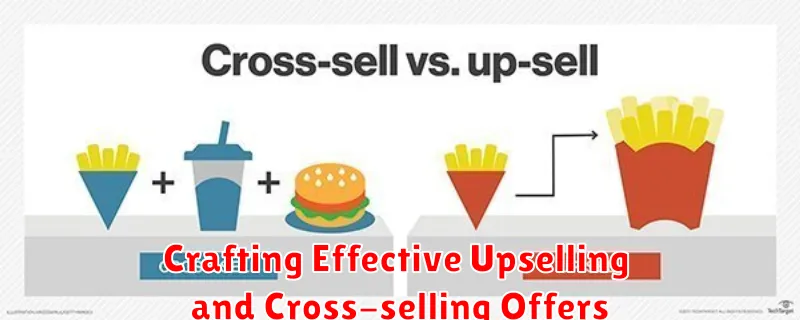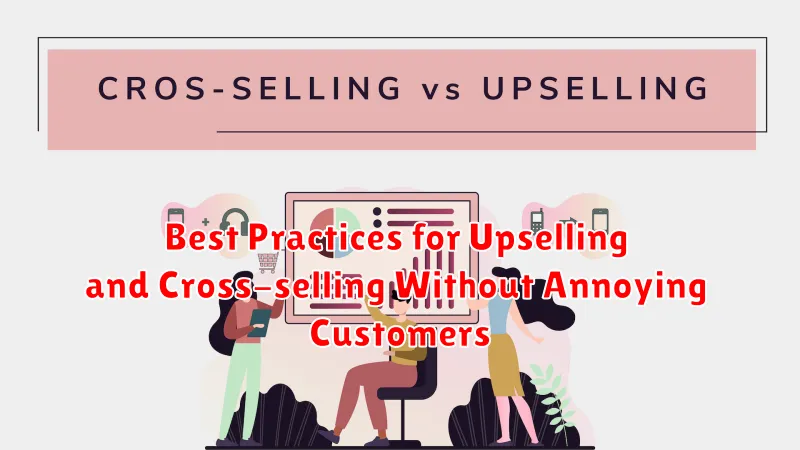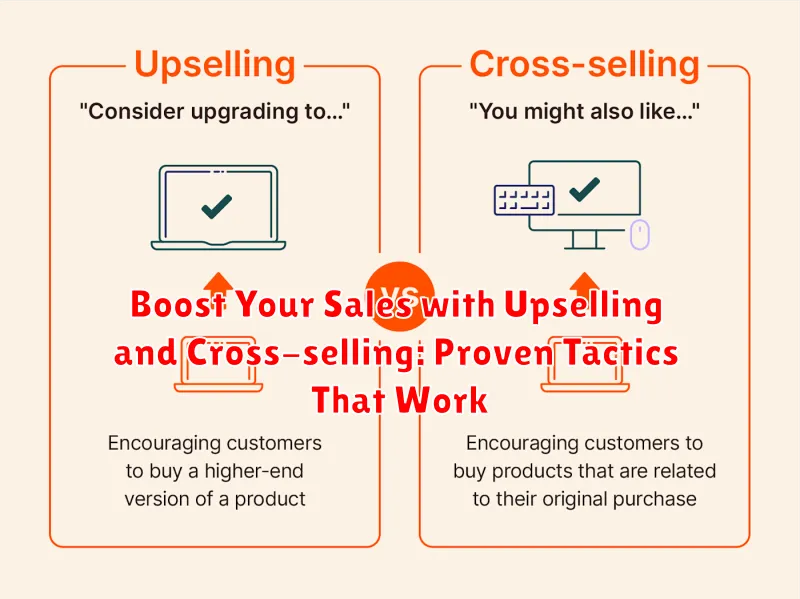Are you looking for effective strategies to boost your sales and increase revenue? Upselling and cross-selling are proven tactics that can significantly impact your bottom line. This article will explore the power of these techniques and provide practical, actionable steps to implement them successfully in your business. Learn how to identify upselling and cross-selling opportunities, tailor your approach to different customer segments, and ultimately, drive more sales.
Mastering the art of upselling and cross-selling is essential for any business seeking sustainable growth. From understanding the subtle differences between these two powerful techniques to crafting compelling offers, this guide will equip you with the knowledge and tools you need to maximize your sales potential. Discover how to effectively upsell and cross-sell to existing customers and new prospects, increasing customer lifetime value and boosting your overall profitability. We will delve into proven tactics, real-world examples, and best practices to ensure your upselling and cross-selling efforts are both effective and ethical.
Understanding Upselling and Cross-selling Techniques
Upselling and cross-selling are powerful sales techniques that encourage customers to purchase more, increasing average order value and revenue. Upselling focuses on persuading customers to buy a higher-end version of the product they are already interested in. This could involve suggesting a premium model with additional features or a larger quantity of the same item.
Cross-selling, on the other hand, involves suggesting related or complementary products to a customer’s initial purchase. These recommendations are based on the customer’s current selection and aim to enhance their overall experience or fulfill additional needs. For example, offering a protective case with a new phone or suggesting matching accessories with a clothing item.
Both techniques rely on understanding customer needs and offering relevant suggestions. A successful upsell or cross-sell should feel like a helpful recommendation, not a pushy sales tactic. The key is to demonstrate added value and enhance the customer’s perceived benefit.
Identifying the Right Products for Upselling and Cross-selling
Choosing the right products for upselling and cross-selling is crucial for maximizing their effectiveness. It’s not just about offering any product, but offering products that genuinely enhance the customer’s experience or fulfill a related need.
For upselling, focus on products that are a premium version of the item the customer is already considering. Think about upgrades, enhanced features, or larger quantities. The key is to offer a clear value proposition that justifies the higher price.
Cross-selling involves suggesting complementary items. Consider products frequently purchased together or those that enhance the functionality or enjoyment of the initial purchase. For instance, a customer buying a camera might also need a memory card, lens, or carrying case.
Product relevance is paramount. Analyze your sales data to understand customer purchase patterns and identify products frequently bought together. This data-driven approach will guide your selection process and increase the likelihood of conversion.
Implementing Upselling and Cross-selling Strategies on Your Website
Strategic placement is key to maximizing the effectiveness of upselling and cross-selling initiatives. Product pages, shopping carts, and even checkout pages present prime opportunities.
On product pages, suggest premium versions or related accessories. For example, if a customer is viewing a basic laptop, offer an upgraded model with more storage or a faster processor. Highlighting complementary items, like a laptop case or a wireless mouse, facilitates cross-selling.
The shopping cart provides another valuable touchpoint. Before customers proceed to checkout, suggest related products they may have overlooked. Clearly displaying these items with concise descriptions and compelling visuals can significantly increase average order value.
Even during checkout, there’s an opportunity to present last-minute add-ons. Offer warranties, expedited shipping, or small, inexpensive items that complement the existing purchase.
User experience is paramount. Ensure that upselling and cross-selling suggestions are seamlessly integrated and not intrusive. Clear labeling, concise descriptions, and easy-to-dismiss options prevent customer frustration and encourage engagement.
Crafting Effective Upselling and Cross-selling Offers

Creating compelling upselling and cross-selling offers involves understanding your customer’s needs and presenting relevant products in an appealing way. Value is the key driver. Clearly communicate the benefits of choosing the upgraded or additional item.
For upselling, highlight the enhanced features, superior performance, or increased longevity of the premium product. Quantify the improvements whenever possible. For example, instead of saying “better performance,” say “20% faster processing speed.”
Cross-selling offers should address complementary needs. Explain how the suggested item enhances the initial purchase. For instance, if a customer adds a camera to their cart, suggest a compatible memory card or lens.
Pricing is also crucial. Upsells should offer a reasonable price jump for the added value. Cross-sells should be perceived as affordable additions, not major expenses. Consider offering bundled deals or discounts for combined purchases to incentivize customers.
Measuring the Success of Your Upselling and Cross-selling Efforts
Tracking the performance of your upselling and cross-selling initiatives is crucial to understanding their impact on your bottom line. Key Performance Indicators (KPIs) provide quantifiable metrics to evaluate effectiveness and identify areas for improvement.
Monitor the following KPIs to gauge the success of your strategies:
- Upselling/Cross-selling Conversion Rate: This metric tracks the percentage of customers who accept an upsell or cross-sell offer. A higher conversion rate indicates effective offer presentation and product selection.
- Average Order Value (AOV): Observe any increases in AOV resulting from successful upselling and cross-selling. This indicates a direct impact on revenue generation.
- Revenue Generated from Upselling/Cross-selling: Track the specific revenue attributed to these techniques. This isolates their contribution to overall sales growth.
- Product Affinity: Analyze which products are frequently purchased together. This data informs future upselling and cross-selling strategies by highlighting relevant product combinations.
Regularly reviewing these KPIs provides valuable insights into the effectiveness of your upselling and cross-selling efforts, allowing you to refine your strategies for optimal results.
Best Practices for Upselling and Cross-selling Without Annoying Customers

Upselling and cross-selling can significantly boost sales, but it’s crucial to implement these strategies without alienating customers. Relevance is key. Offer suggestions that genuinely complement the customer’s current selection or anticipated needs.
Timing also plays a vital role. Introduce upsells or cross-sells after the customer has committed to the initial purchase, not before. This reduces the perception of pressure.
Personalization enhances the customer experience. Use data to understand individual preferences and tailor recommendations accordingly. Avoid generic, blanket offers.
Limit the number of suggestions. Offering too many options can overwhelm the customer. Focus on a select few highly relevant products or services.
Finally, respect the customer’s decision. If they decline an upsell or cross-sell, accept their choice gracefully and move forward. Never pressure them into additional purchases.
Using Data and Analytics to Refine Your Approach
Data and analytics play a crucial role in optimizing upselling and cross-selling strategies. By analyzing customer purchase history, browsing behavior, and demographics, businesses can gain valuable insights into customer preferences and needs.
Tracking key metrics such as conversion rates, average order value (AOV), and customer lifetime value (CLTV) allows you to measure the effectiveness of your current strategies. Identify which products are frequently purchased together and which upsells or cross-sells are most successful.
Use this data to segment your customer base and create targeted offers. For example, customers who have previously purchased a specific product may be more receptive to an upsell for a premium version. Similarly, customers who browse certain product categories may be interested in related cross-sell offers.
A/B testing different offers and messaging can help you determine what resonates best with each customer segment. Continuously analyze the data and refine your approach to maximize the impact of your upselling and cross-selling efforts.
Examples of Successful Upselling and Cross-selling in Action
Fast Food Combo Upgrade: A customer orders a burger. The cashier suggests upgrading to a combo meal with fries and a drink for a slightly higher price. This is a classic upselling example.
Electronics Warranty Extension: A customer purchases a new television. The salesperson offers an extended warranty, covering potential repairs beyond the manufacturer’s standard warranty. This is another form of upselling, focusing on increased value and peace of mind.
E-commerce Product Recommendations: A customer adds a laptop to their online shopping cart. The website suggests a compatible mouse, laptop bag, or external hard drive. This is cross-selling, offering related products to complement the initial purchase.
Software Subscription Enhancements: A customer subscribes to a basic software plan. The company offers them a premium plan with additional features like increased storage, collaborative tools, or priority support. This is an example of upselling a service.

